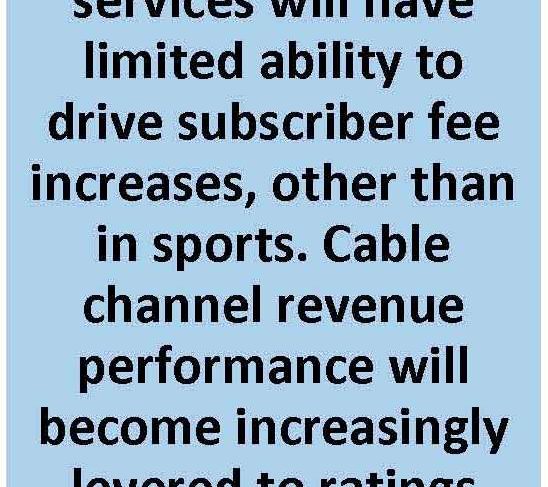
AS THE ENTIRE INDUSTRY, indeed as the whole media world, continues to change, Canadian cable companies and specialty channels are going to struggle to find growth, according to a report from BMO Capital Markets.
Telco IPTV services, such as Telus’ Optik and Bell’s Fibe along with the myriad online video options available to Canadians to view their favourite shows will keep pressure on Canadian cable companies and specialty channel owners. While about 62% of Canadian households subscribe to cable, as Telus and Bell’s IPTV options gain strength cable’s level of penetration will decline by a percent a year says the report, authored by BMOCM’s cable and media analyst Tim Casey. With Canadians swapping one terrestrial carrier (cable) for another (telco), those switches will largely be a wash for specialty channel owners.
Sources have told Cartt.ca of late that Telus has already surpassed the 500,000-customer mark on the TV side with Optik, and Bell is about to take on Cogeco as it plans to launch Fibe in Oakville in March, moving beyond the immediate Greater Toronto Area. According to Casey, “Telus’s video service, branded as Optik, has already attracted more than 450k video subscribers, representing more than 21% of its available footprint (2.1 million homes). Given its success to date, it would not surprise us if Telus extended its Optik footprint by another say, 20%. Bell’s service is known as Fibe and is roughly a year or two behind Telus. Bell expects to have the service available in 2 million homes by end of 2011 and 5 million by the end of 2015. Bell does not release segmented Fibe customer data.”
When it comes to web video viewing, while none of the established players are in serious trouble right now, writes Casey, whose report was written just before Christmas, “specialty channel operators seem more at risk from the foregoing shift to web video. Over time, the financial metrics of weaker (read less-viewed) channels are likely to deteriorate as carriage more closely tracks viewership.”
That also means, says the report, that growth will come from advertising, and not from increases in subscriber fees, meaning bigger ratings will be absolutely required. “We believe specialty services will have limited ability to drive subscriber fee increases, other than in sports. Cable channel revenue performance will become increasingly levered to ratings performance,” reads the report. “Cable channel viewership continues to benefit from a secular shift out of conventional (over-the-air or OTA) channels into cable channels. Corus estimates cable channels currently represent 55% of viewing but only 36% of revenues. The viewing/revenue ratio is up materially from five years ago when it was 45%/18%. We doubt the viewing/ revenue ratio will ever reach 1x given the superior reach of OTA.”

All of that said, “there seems to be no imminent catalyst to collapse the current practice of packaging cable channels into tiers and bundled offerings,” says the report. “In other words, we do not foresee a meaningful shift to à la carte consumption of video services in the medium term.”
Even so, the business model of the cable industry is rapidly moving away from selling TV tiers to providing broadband as the industry prepares for consumers to consume ever more online video. However, “the pace of this evolution is driven forward by consumer behaviour (essentially, more video consumption options and greater data demand) but restrained by legacy business models,” reads the report.
“In short, the incumbent video providers are all in this together. The video food chain – distributor (cable/telephone/satellite company), packager (cable channel owner) and content owner (studio) – have profited from a model based on video tiers or channel packages. There is no industry catalyst to collapse this packaging model and move to à la carte,” says the report.
Plus, it’s just not easy enough yet, nor is there enough programming available on new platforms, for most consumers to switch to over-the-top (OTT) video only. “There seems to be no meaningful financial incentive for average television viewers to switch to web video or over-the-top (OTT) services. OTT will appeal to consumers who watch little television. We expect cable companies will still monetize web viewers,” writes Casey.
– Greg O’Brien



